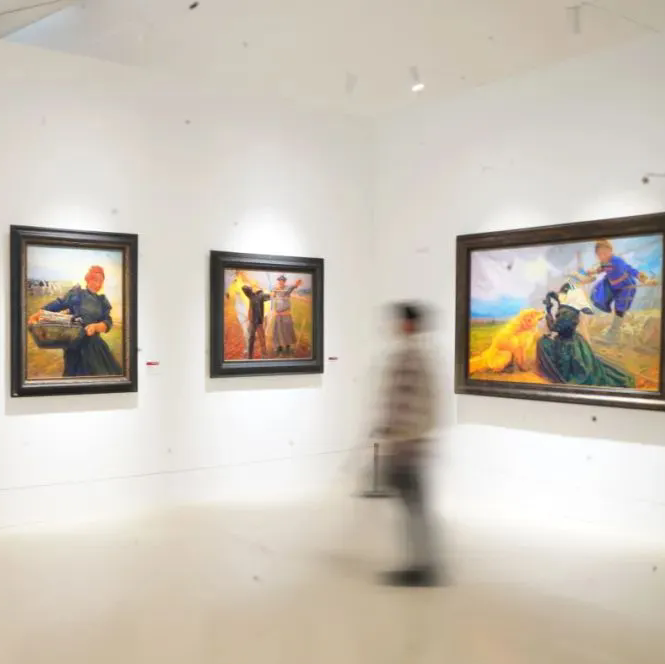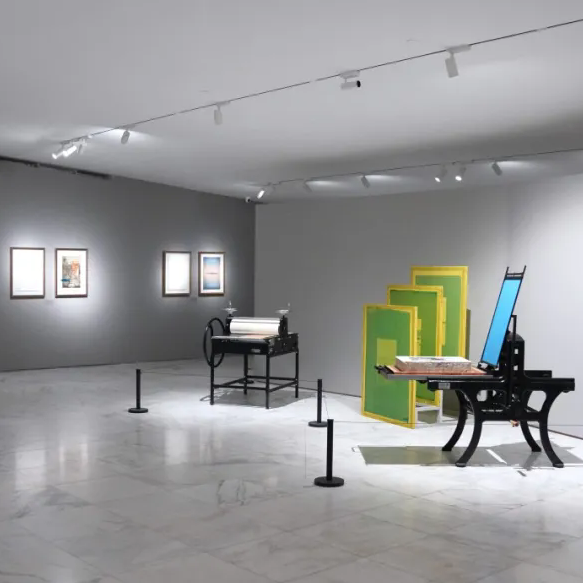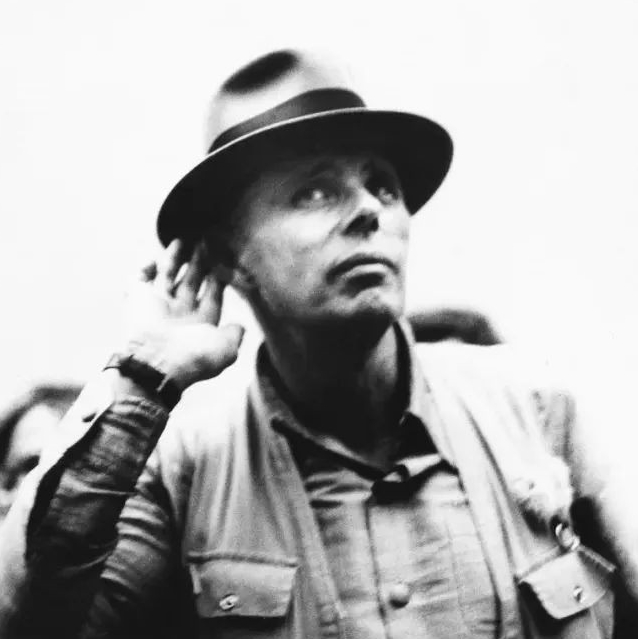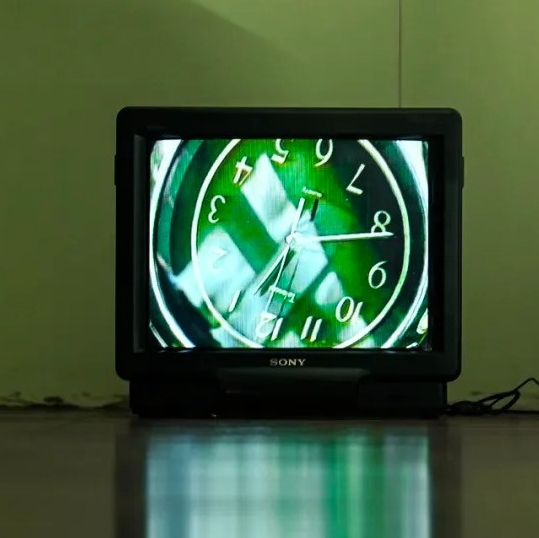“Dunhuang and I: Painting Exhibition of Jin Shangyi and Tang Yongli” was recently revealed at Nanchizi Museum, featuring Mr. Jin Shangyi’s six pieces of artworks copied after murals of Dunhuang Grottoes in 1978 . From Mr. Jin’s viewpoint, this series of work is “painting from life” with a clear intention rather than barely copying art. The intention mentioned here includes studying the colors and figures of mural paintings in Dunhuang from a perspective of “painting from nature” by oil painting. Mr. Jin Shangyi always maintains a clear direction in his learning and exploration process, sticking to integrity for the truth and insisting on discovering and solving problems in fine art. The extremely clear artistic intuition and rigorous thinking ability are precisely implemented in the process of his learning in drawings and creative exploration.



Exhibition View
Sketching is a fundamental course in fine arts. With profound modeling skills, Mr. Jin's drawings have been repeatedly studied and imitated by art candidates for many years. For a long time, most people have not yet appreciated the independent value of Mr. Jin's drawings, nor have they realized the interaction between his drawings and oil paintings.
On 10th September 2022, “The Integrity of Vision: An Exhibition of Jin Shangyi’s Drawings” kicked off at the Chinese Academy of Oil Painting Display Gallery, featuring monographic research on Mr. Jin Shangyi’s sketching art. As a leading figure in the Chinese art circle, Mr. Jin Shangyi's experience in art and education spans almost the same period as the People’s Republic of China. Moreover, his artistic practice and research are deeply involved in the historical process of the cultural construction of New China. Also, his solid foundation in sketching and modeling skills are far from easy.



Exhibition View
The entire exhibition continues to unfold in 11 small and exquisite display galleries. The five primary themes of “Initial Knowledge on Structure”, “Practicing Structure”, “Embracing and Inclusiveness", “Interlink of Heart and Hand”, and “Human Body and Manuscripts” comprehensively and systematically sort out and present nearly 160 drawings created by Mr. Jin from 1953 to 2006. The presentation of this exhibition has also announced another in-depth research process of the “Case Study Exhibition” series for outstanding artists organized by the Chinese Academy of Oil Painting.



Exhibition View
In 1949, 15-year-old Jin Shangyi was accepted by the Painting Department of the National Art School in Beiping (now China Central Academy of Fine Arts). At the time, the Oil Painting Department has not yet been established, and the sketching course followed the teaching method was introduced by Mr. Xu Beihong from France. Mr. Xu Beihong concluded the method of sketching by “penetrating all subtleties, reaching the breadth and greatness”, and “better to be square than round, and rather dirty than clean”. The former pursues a sense of integrity, requiring majestic and integrated overall feelings from a distance and the subtle and microscopic details by taking a closer look. While the latter requires students to pay attention to volume, faceting, space, anatomy, etc. At the time, the method to ensure the accuracy of the form was still primary. A stick was used to measure the horizontal and vertical lines, and regulate the contour and the angle of inclination. Jin Shangyi gradually realized that although this method makes the sketches of a beginner look vivid, the overall picture effect is relatively scattered.

Jin Shangyi, “Portrait of Cai Liang”, 27.5×19.5cm, 1953 Jin Shangyi, “Portrait of Cai Liang”, 27.5×19.5cm, 1953
Jin Shangyi, “Portrait of Cai Liang”, 27.5×19.5cm, 1953

Jin Shangyi, “Portrait of Jin Zhilin”, 30.5cm×23cm, 1954
In 1955, Jin Shangyi took part in the Oil Painting Training Class led by Максимов.K.M, which introduced him to another method, namely, structure sketching. “With beams and pillars, the structure (sketch) is similar to building a house, erecting a framework, and then stacking them with bricks and tiles to connect. In a word, it cannot be empty whatever you paint. It is necessary to see both the outside and inside, as every object is composed of both outside and inside parts.” [1]

Jin Shangyi, “Western Suburbs of Beijing”, 37.5cmx29.5cm, 1953

Jin Shangyi, “Trees in Wushao Mountain”, 39.7cmx27.8cm, 1954
The so-called “connection” of structure addressed by Максимов.K.M guided the students to study anatomical knowledge such as bones and muscles for the first step. From Максимов.K.M’s viewpoint, “the human body is the connection between the bones and the muscles”, and “it is impossible to be accurate without understanding the structure. The human body (in the picture) would be scattered, messy, and soft without understanding structure.” [2] Максимов.K.M’s addition to the knowledge of “structure” enabled Jin Shangyi to comprehensively understand the characteristics of the Western model sketching system for the first time. This new sketch concept has shifted the way that Chinese people recognize objects, and allowed Chinese artists in the 1950s to learn about the relationship between the essence and mass of the object shape through the light and shadow on the surface. Introducing structure to sketch education in China which was the most significant contribution that Максимов.K.M’s Oil Painting Training Class has made, led a new beginning to the teaching of sketching in our country.

Jin Shangyi, “Head Portrait of Yang Shuqing”, 38cmx29cm, 1957
 Jin Shangyi, “An Old Lady”, 76.5cmx58.5cm, 1958
Jin Shangyi, “An Old Lady”, 76.5cmx58.5cm, 1958

Jin Shangyi, “An Old Lady”, 39cmx27cm, 1962
However, it still took Jin Shangyi seven to eight years to apply the concept of structure sketching to practice. With wisdom in terms of profound reflections on clues and dramatically diligent work, he deeply understood and finally solved the problem of “structure” in sketches, namely, a part of the problem of “shaping/modeling" in fine arts.
Graduated from the Oil Painting Training Class led by Максимов.K.M in 1957, Jin Shangyi was allocated to the Printmaking Department together with Li Hua, Gu Yuan, Huang Yongyu, and Wu Biduan. During his five years in the Printmaking Department, Jin Shangyi repeatedly drew human bodies, portraits, and skulls. Through training hard, he made efforts to master the structure of sketching. It was extremely difficult to complete the process from recognition to practice. As he recalled, “I can't remember how many sketches I have drawn, but I think there are always tens of thousands.”

Jin Shangyi, “Male Body”, 76.5cmx58.5cm, 1957
In the chapters of “Initial Knowledge on Structure” and “Practicing Structure”, the exhibition showcased the achievements of Mr. Jin during his exploration period, including a large number sketches of portraits, human bodies, and research pieces of the internal structure of the human bodies, among others. These long-term and in-depth research achievements in sketching have successfully consolidated the basic skills for Jin Shangyi's follow-up exploration in oil painting.
 Jin Shangyi, "Back View of Male Body", 78cmx54cm, 1957
Jin Shangyi, "Back View of Male Body", 78cmx54cm, 1957

Jin Shangyi, "Standing Male Body Study", 78cm×54cm, 1958
The clear clue of the exhibition provides the audience with an opportunity to understand Jin Shangyi’s development in the art of sketching—starting from realistic painting, then he approached Pavel Chistyakov’s sketch system under the personal supervision of Максимов.K.M, and later he made a great effort in integrating the two methods into his practice. Whether it is for Jin Shangyi's individual creative perspective, or the Chinese art circle at the initial stage of oil painting at that time, learning the strengths of each school has become the most effective way to seize the opportunities of the times.

Jin Shangyi, “Singer”, 39cmx27cm, 1963

Jin Shangyi, “Portrait of a CAFA Classmate”, 39.5cmx28.5cm,1965
 Jin Shangyi, “Xiao Gao Wearing a Bamboo Hat”, 39.5x55.5cm, 1967
Jin Shangyi, “Xiao Gao Wearing a Bamboo Hat”, 39.5x55.5cm, 1967
In 1962, Jin Shangyi was transferred from the Printmaking Department to the Studio One led by Wu Zuoren of the Oil Painting Department at CAFA. It was precisely in the early 1960s that Jin Shangyi eventually felt that he had passed the barrier of the sketch. Since then, he has started to enter a new artistic stage of exploring the language and spiritual characteristics of culture regarding Eastern and Western painting, searching for the possibility of integrating Chinese cultural connotations with Western oil painting techniques in his oil paintings.

Jin Shangyi, “Portrait of A Young Woman from Beijing Military Region”, 36cmx27cm, 1971

Jin Shangyi, “Portrait of Xiao Qin”, 36.5x28cm, 1972

Jin Shangyi, “Portrait of Zhang Zhixin”, 39.5x27cm, 1975
 Jin Shangyi, “A Northern Girl”, 53.3cmx39.4cm, 1976
Jin Shangyi, “A Northern Girl”, 53.3cmx39.4cm, 1976
With his attention to reality from a modern perspective and the essence of classical painting, a concise and generalized painting language, and a deep combination of research and expression, Mr. Jin Shangyi developed a new dimension of contemporary Chinese oil painting in the fusion of the modeling features of oil paintings and oriental aesthetics, showing the artist’s understanding of the zeitgeist and the strong response to it at a certain historical stage.

Jin Shangyi, “A Tibetan Girl”, 44cmx38.8cm, 1978

Jin Shangyi, “A Tibetan Girl”, 38cmx26.5cm, 1978

Jin Shangyi, “A Sculptor Portrait”, 53cmx39cm, 1979
The inseparable relationship between sketch and oil painting is concentrated in the last exhibition hall, featuring the complete creative process of Jin Shangyi’s several important oil paintings, which offers a detailed and intuitive presentation to the audience.
Undoubtedly, sketching is the foundation of fine arts, and solving the internal problem of sketch could only be the first step. Mr. Jin stated that it took him at least 15 years and three stages to completely combine the light and shadow on the surface with the inner structure. “It took me several decades to understand sketch from partly to comprehensively. However, it took a long time then to apply what I have understood and practiced to oil painting creation. By the 1980s, when I was over fifty years old, I was barely able to solve these basic problems.” In the exhibition, it is clear that in the tough exploring process featuring the progressive three stages, Mr. Jin Shangyi has always insisted on starting from the ontology language of art, focusing on solving related issues such as the localization and the epochal characteristics of the oil paintings, which also runs through the entire development process of Chinese art education.


Manuscripts of “Bada Shanren”


Manuscripts of “A Doctor”


Manuscripts of “Painter Zhan Jianjun”


Manuscripts of “Painter Huang Binhong"
A symposium entitled “The Significance of Sketch” held on the opening day online and offline at the same time, discussing three themes of “the Sketch Created by Mr. Jin Shangyi”, “the Value and Significance of the Sketch and How to Understand the Sketch”, and “the Sketch and the Development of Contemporary Chinese Fine Arts”. Mr. Jin Shangyi, Honorary Chairman of the China Artists Association and former President of the Central Academy of Fine Arts, Professor and Doctoral Supervisor Yang Feiyun, who serves as the Dean of Chinese Academy of Oil Painting, He Jiaying, Vice Chairman of the China Artists Association and Doctoral Supervisor of the Chinese National Academy of Arts, Professor and Doctoral Supervisor Tang Yongli, who serves as the Deputy Director of the Academic Committee of the Central Academy of Fine Arts, Li Xiaolin, Professor and Doctoral Supervisor of the Printmaking Department of the Central Academy of Fine Arts, and Deputy Director of the Watercolor Art Committee of the China Artists Association, Zhu Chunlin, Vice Dean of Chinese Academy of Oil Painting,, Doctoral Supervisor and Council Member of China Oil Painting Society, were invited to participate in the symposium. Shang Hui, Director of the Art Theory Committee of the China Artists Association and Editor-in-chief of Art Magazine, chaired the symposium.


View of Symposium
Starting from Mr. Jin Shangyi's sketches, the guests in the symposium deeply discussed the inner meaning and construction concept of sketches, and the structural relationship between oil painting, printmaking, and traditional Chinese painting, among others. Since the sketch is the foundation of fine art and can solve all problems except color, discussing sketch-related issues allows for concern about the foundation, which also bears forward-looking and instructive meaning for the future inheritance and development of art.

View of Symposium
Text by Mengxi, translated by Emily and edited by Sue.
Courtesy of the organizer.
References:
[1] Exhibition Text.
[2] Jin Shangyi, Fan Di’an, The Art of Jin Shangyi - A Full Record, Nanjing: Jiangsu Fine Arts Publishing House, 2009.05.
[3] Forward of the Exhibition.




























